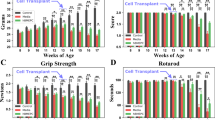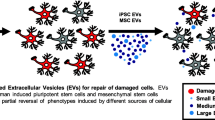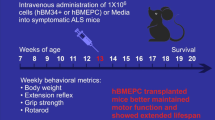Abstract
Repairing the damaged blood-CNS-barrier in amyotrophic lateral sclerosis (ALS) is necessary to prevent entry of detrimental blood-borne factors contributing to motor neuron dysfunction. Recently, we showed benefits of human bone marrow endothelial progenitor cell (hBM-EPC) transplantation into symptomatic ALS mice on barrier restoration by replacing damaged endothelial cells (ECs). Additionally, transplanted cells may endogenously repair ECs by secreting angiogenic factors as our subsequent in vitro study demonstrated. Based on these study results, hBM-EPCs may secrete extracellular vesicles, which may contain and transfer diverse vesicular biomolecules towards maintenance of EC functionality. The study aimed to characterize extracellular vesicles (EVs) derived from hBM-EPCs as potential cell-free therapeutics for endothelium repair in ALS. EVs were isolated from hBM-EPC media at different culture times and vesicle properties were evaluated. The protective effects of EVs on mouse brain endothelial cells (mBECs) exposed to ALS mouse plasma were investigated. Uptake and blockage of EVs from GFP-transfected hBM-EPCs in ECs were determined in vitro. Results showed that EVs isolated from hBM-EPCs as nanosized vesicles significantly reduced mBEC damage from the pathological environment and these EVs were taken up by cells. Blockage of β1 integrin on EVs prevented internalization of vesicles in mBECs. Together, these results provide evidence for potential of hBM-EPC-derived EVs as novel cell-free therapeutics for repair of endothelium in ALS. Although determining translational potential of hBM-EPC-derived EVs will require evaluation in vivo, this in vitro study represents a step towards an extracellular vesicle-based approach for repair of the damaged microvascular endothelium in ALS.






Similar content being viewed by others
References
Aghajani Nargesi, A., Lerman, L. O., & Eirin, A. (2017). Mesenchymal stem cell-derived extracellular vesicles for kidney repair: Current status and looming challenges. Stem Cell Research & Therapy, 8(1), 273. https://doi.org/10.1186/s13287-017-0727-7.
Akers, J. C., Gonda, D., Kim, R., Carter, B. S., & Chen, C. C. (2013). Biogenesis of extracellular vesicles (EV): Exosomes, microvesicles, retrovirus-like vesicles, and apoptotic bodies. Journal of Neuro-Oncology, 113(1), 1–11. https://doi.org/10.1007/s11060-013-1084-8.
Andaloussi, E. L., Mager, S. E., ABreakefield, X. O., & Wood, E. M. J. A. (2013). Extracellular vesicles: Biology and emerging therapeutic opportunities. Nature Reviews. Drug Discovery, 12(5), 347–357. https://doi.org/10.1038/nrd3978.
Bakhshandeh, B., Kamaleddin, M. A., & Aalishah, K. (2017). A comprehensive review on exosomes and microvesicles as epigenetic factors. Current Stem Cell Research & Therapy, 12(1), 31–36. https://doi.org/10.2174/1574888x11666160709211528.
Bobrie, A., Colombo, M., Raposo, G., & Théry, C. (2011). Exosome secretion: Molecular mechanisms and roles in immune responses. Traffic (Copenhagen, Denmark), 12(12), 1659–1668. https://doi.org/10.1111/j.1600-0854.2011.01225.x.
Camussi, G., Deregibus, M. C., Bruno, S., Cantaluppi, V., & Biancone, L. (2010). Exosomes/microvesicles as a mechanism of cell-to-cell communication. Kidney International, 78(9), 838–848. https://doi.org/10.1038/ki.2010.278.
Cantaluppi, V., Biancone, L., Figliolini, F., Beltramo, S., Medica, D., Deregibus, M. C., et al. (2012). Microvesicles derived from endothelial progenitor cells enhance neoangiogenesis of human pancreatic islets. Cell Transplantation, 21(6), 1305–1320. https://doi.org/10.3727/096368911X627534.
Chaput, N., & Théry, C. (2011). Exosomes: Immune properties and potential clinical implementations. Seminars in Immunopathology, 33(5), 419–440. https://doi.org/10.1007/s00281-010-0233-9.
Chernomordik, L. V., & Kozlov, M. M. (2003). Protein-lipid interplay in fusion and fission of biological membranes. Annual Review of Biochemistry, 72, 175–207. https://doi.org/10.1146/annurev.biochem.72.121801.161504.
Choi, D.-S., Kim, D.-K., Kim, Y.-K., & Gho, Y. S. (2015). Proteomics of extracellular vesicles: Exosomes and ectosomes. Mass Spectrometry Reviews, 34(4), 474–490. https://doi.org/10.1002/mas.21420.
Cocucci, E., Racchetti, G., & Meldolesi, J. (2009). Shedding microvesicles: Artefacts no more. Trends in Cell Biology, 19(2), 43–51. https://doi.org/10.1016/j.tcb.2008.11.003.
Colombo, M., Raposo, G., & Théry, C. (2014). Biogenesis, secretion, and intercellular interactions of exosomes and other extracellular vesicles. Annual Review of Cell and Developmental Biology, 30, 255–289. https://doi.org/10.1146/annurev-cellbio-101512-122326.
Dabrowska, S., Andrzejewska, A., Lukomska, B., & Janowski, M. (2019a). Neuroinflammation as a target for treatment of stroke using mesenchymal stem cells and extracellular vesicles. Journal of Neuroinflammation, 16(1), 178. https://doi.org/10.1186/s12974-019-1571-8.
Dabrowska, S., Andrzejewska, A., Strzemecki, D., Muraca, M., Janowski, M., & Lukomska, B. (2019b). Human bone marrow mesenchymal stem cell-derived extracellular vesicles attenuate neuroinflammation evoked by focal brain injury in rats. Journal of Neuroinflammation, 16(1), 216. https://doi.org/10.1186/s12974-019-1602-5.
Das, C. K., Jena, B. C., Banerjee, I., Das, S., Parekh, A., Bhutia, S. K., et al. (2019). Exosome as a novel shuttle for delivery of therapeutics across biological barriers. Molecular Pharmaceutics, 16(1), 24–40. https://doi.org/10.1021/acs.molpharmaceut.8b00901.
Deregibus, M. C., Cantaluppi, V., Calogero, R., Lo Iacono, M., Tetta, C., Biancone, L., et al. (2007). Endothelial progenitor cell derived microvesicles activate an angiogenic program in endothelial cells by a horizontal transfer of mRNA. Blood, 110(7), 2440–2448. https://doi.org/10.1182/blood-2007-03-078709.
Ehrhart, J., Sanberg, P. R., & Garbuzova-Davis, S. (2018). Plasma derived from human umbilical cord blood: Potential cell-additive or cell-substitute therapeutic for neurodegenerative diseases. Journal of Cellular and Molecular Medicine, 22(12), 6157–6166. https://doi.org/10.1111/jcmm.13898.
Ehrhart, J., Smith, A. J., Kuzmin-Nichols, N., Zesiewicz, T. A., Jahan, I., Shytle, R. D., et al. (2015). Humoral factors in ALS patients during disease progression. Journal of Neuroinflammation, 12, 127. https://doi.org/10.1186/s12974-015-0350-4.
Eve, D. J., Steiner, G., Mahendrasah, A., Sanberg, P. R., Kurien, C., Thomson, A., et al. (2018). Reduction of microhemorrhages in the spinal cord of symptomatic ALS mice after intravenous human bone marrow stem cell transplantation accompanies repair of the blood-spinal cord barrier. Oncotarget, 9(12), 10621–10634. https://doi.org/10.18632/oncotarget.24360.
Furuta, T., Miyaki, S., Ishitobi, H., Ogura, T., Kato, Y., Kamei, N., et al. (2016). Mesenchymal stem cell-derived exosomes promote fracture healing in a mouse Model. Stem Cells Translational Medicine, 5(12), 1620–1630. https://doi.org/10.5966/sctm.2015-0285.
Garbuzova-Davis, S., Ehrhart, J., Mustafa, H., Llauget, A., Boccio, K. J., Sanberg, P. R., et al. (2019a). Phenotypic characteristics of human bone marrow-derived endothelial progenitor cells in vitro support cell effectiveness for repair of the blood-spinal cord barrier in ALS. Brain Research, 1724, 146428. https://doi.org/10.1016/j.brainres.2019.146428.
Garbuzova-Davis, S., Ehrhart, J., Sanberg, P. R., & Borlongan, C. V. (2018a). Potential role of humoral IL-6 cytokine in mediating pro-inflammatory endothelial cell response in amyotrophic lateral sclerosis. International Journal of Molecular Sciences. https://doi.org/10.3390/ijms19020423.
Garbuzova-Davis, S., Haller, E., Navarro, S., Besong, T. E., Boccio, K. J., Hailu, S., et al. (2018b). Transplantation of human bone marrow stem cells into symptomatic ALS mice enhances structural and functional blood-spinal cord barrier repair. Experimental Neurology, 310, 33–47. https://doi.org/10.1016/j.expneurol.2018.08.012.
Garbuzova-Davis, S., Kurien, C., Haller, E., Eve, D. J., Navarro, S., Steiner, G., et al. (2019b). Human bone marrow endothelial progenitor cell transplantation into symptomatic ALS mice delays disease progression and increases motor neuron survival by repairing blood-spinal cord barrier. Scientific Reports, 9(1), 5280. https://doi.org/10.1038/s41598-019-41747-4.
Garbuzova-Davis, S., Kurien, C., Thomson, A., Falco, D., Ahmad, S., Staffetti, J., et al. (2017). Endothelial and astrocytic support by human bone marrow stem cell grafts into symptomatic ALS mice towards blood-spinal cord barrier repair. Scientific Reports, 7(1), 884. https://doi.org/10.1038/s41598-017-00993-0.
Gho, Y. S., & Lee, C. (2017). Emergent properties of extracellular vesicles: A holistic approach to decode the complexity of intercellular communication networks. Molecular Biosystems, 13(7), 1291–1296. https://doi.org/10.1039/c7mb00146k.
Gould, S. J., & Raposo, G. (2013). As we wait: coping with an imperfect nomenclature for extracellular vesicles. Journal of Extracellular Vesicles, 2, https://doi.org/10.3402/jev.v2i0.20389.
György, B., Szabó, T. G., Pásztói, M., Pál, Z., Misják, P., Aradi, B., et al. (2011). Membrane vesicles, current state-of-the-art: Emerging role of extracellular vesicles. Cellular and Molecular Life Sciences, 68(16), 2667–2688. https://doi.org/10.1007/s00018-011-0689-3.
Hill, A. F., Pegtel, D. M., Lambertz, U., Leonardi, T., O’Driscoll, L., Pluchino, S., et al. (2013). ISEV position paper: Extracellular vesicle RNA analysis and bioinformatics. Journal of Extracellular Vesicles,. https://doi.org/10.3402/jev.v2i0.22859.
Hu, Y., Cao, C., Qin, X.-Y., Yu, Y., Yuan, J., Zhao, Y., et al. (2017). Increased peripheral blood inflammatory cytokine levels in amyotrophic lateral sclerosis: A meta-analysis study. Scientific Reports, 7(1), 9094. https://doi.org/10.1038/s41598-017-09097-1.
Igami, K., Uchiumi, T., Ueda, S., Kamioka, K., Setoyama, D., Gotoh, K., et al. (2020). Characterization and function of medium and large extracellular vesicles from plasma and urine by surface antigens and Annexin V. PeerJ Analytical Chemistry, 2, e4. https://doi.org/10.7717/peerj-achem.4.
Iraci, N., Leonardi, T., Gessler, F., Vega, B., & Pluchino, S. (2016). Focus on extracellular vesicles: physiological role and signalling properties of extracellular membrane vesicles. International Journal of Molecular Sciences, 17(2), 171. https://doi.org/10.3390/ijms17020171.
Jeyachandran, A., Mertens, B., McKissick, E. A., & Mitchell, C. S. (2015). Type I Vs Type II cytokine levels as a function of SOD1 G93A mouse amyotrophic lateral sclerosis disease progression. Frontiers in Cellular Neuroscience, 9, 462. https://doi.org/10.3389/fncel.2015.00462.
Kalluri, R., & LeBleu, V. S. (2020). The biology, function, and biomedical applications of exosomes. Science. https://doi.org/10.1126/science.aau6977.
Kim, K. M., Abdelmohsen, K., Mustapic, M., Kapogiannis, D., & Gorospe, M. (2017). RNA in extracellular vesicles. Wiley Interdisciplinary Reviews. https://doi.org/10.1002/wrna.1413.
Kowal, J., Arras, G., Colombo, M., Jouve, M., Morath, J. P., Primdal-Bengtson, B., et al. (2016). Proteomic comparison defines novel markers to characterize heterogeneous populations of extracellular vesicle subtypes. Proceedings of the National Academy of Sciences of the United States of America, 113(8), E968–977. https://doi.org/10.1073/pnas.1521230113.
Lai, R. C., Arslan, F., Lee, M. M., Sze, N. S. K., Choo, A., Chen, T. S., et al. (2010). Exosome secreted by MSC reduces myocardial ischemia/reperfusion injury. Stem Cell Research, 4(3), 214–222. https://doi.org/10.1016/j.scr.2009.12.003.
Lam, L., Chin, L., Halder, R. C., Sagong, B., Famenini, S., Sayre, J., et al. (2016). Epigenetic changes in T-cell and monocyte signatures and production of neurotoxic cytokines in ALS patients. FASEB Journal, 30(10), 3461–3473. https://doi.org/10.1096/fj.201600259RR.
Lee, Y., El Andaloussi, S., & Wood, M. J. A. (2012). Exosomes and microvesicles: extracellular vesicles for genetic information transfer and gene therapy. Human Molecular Genetics, 21(R1), R125–134. https://doi.org/10.1093/hmg/dds317.
Mateescu, B., Kowal, E. J. K., van Balkom, B. W. M., Bartel, S., Bhattacharyya, S. N., Buzás, E. I., et al. (2017). Obstacles and opportunities in the functional analysis of extracellular vesicle RNA - an ISEV position paper. Journal of Extracellular Vesicles, 6(1), 1286095. https://doi.org/10.1080/20013078.2017.1286095.
Moreno-Martínez, L., Calvo, A. C., Muñoz, M. J., & Osta, R. (2019a). Are circulating cytokines reliable biomarkers for amyotrophic lateral sclerosis? International Journal of Molecular Sciences. https://doi.org/10.3390/ijms20112759.
Moreno-Martínez, L., de la Torre, M., Toivonen, J. M., Zaragoza, P., García-Redondo, A., Calvo, A. C., et al. (2019b). Circulating cytokines could not be good prognostic biomarkers in a mouse model of amyotrophic lateral sclerosis. Frontiers in Immunology, 10, 801. https://doi.org/10.3389/fimmu.2019.00801.
Morrison, T. J., Jackson, M. V., Cunningham, E. K., Kissenpfennig, A., McAuley, D. F., O’Kane, C. M., et al. (2017). Mesenchymal stromal cells modulate macrophages in clinically relevant lung injury models by extracellular vesicle mitochondrial transfer. American Journal of Respiratory and Critical Care Medicine, 196(10), 1275–1286. https://doi.org/10.1164/rccm.201701-0170OC.
Mulcahy, L. A., Pink, R. C., & Carter, D. R. F. (2014). Routes and mechanisms of extracellular vesicle uptake. Journal of Extracellular Vesicles,. https://doi.org/10.3402/jev.v3.24641.
Osteikoetxea, X., Balogh, A., Szabó-Taylor, K., Németh, A., Szabó, T. G., Pálóczi, K., et al. (2015). Improved characterization of EV preparations based on protein to lipid ratio and lipid properties. PLoS ONE, 10(3), e0121184. https://doi.org/10.1371/journal.pone.0121184.
Qiu, G., Zheng, G., Ge, M., Wang, J., Huang, R., Shu, Q., et al. (2018). Mesenchymal stem cell-derived extracellular vesicles affect disease outcomes via transfer of microRNAs. Stem Cell Research & Therapy, 9(1), 320. https://doi.org/10.1186/s13287-018-1069-9.
Rana, S., & Zöller, M. (2011). Exosome target cell selection and the importance of exosomal tetraspanins: A hypothesis. Biochemical Society Transactions, 39(2), 559–562. https://doi.org/10.1042/BST0390559.
Raposo, G., & Stoorvogel, W. (2013). Extracellular vesicles: Exosomes, microvesicles, and friends. The Journal of Cell Biology, 200(4), 373–383. https://doi.org/10.1083/jcb.201211138.
Robbins, P. D., & Morelli, A. E. (2014). Regulation of immune responses by extracellular vesicles. Nature Reviews. Immunology, 14(3), 195–208. https://doi.org/10.1038/nri3622.
Shojaati G, Khandaker I, Funderburgh ML, Mann MM, Basu R, Stolz DB et al. (2019). Mesenchymal stem cells reduce corneal fibrosis and inflammation via extracellular vesicle-mediated delivery of miRNA. Stem Cells Translational Medicine. 8(11), 1192-1201
Stone, M. L., Zhao, Y., Robert Smith, J., Weiss, M. L., Kron, I. L., Laubach, V. E., et al. (2017). Mesenchymal stromal cell-derived extracellular vesicles attenuate lung ischemia-reperfusion injury and enhance reconditioning of donor lungs after circulatory death. Respiratory Research, 18(1), 212. https://doi.org/10.1186/s12931-017-0704-9.
Subra, C., Laulagnier, K., Perret, B., & Record, M. (2007). Exosome lipidomics unravels lipid sorting at the level of multivesicular bodies. Biochimie, 89(2), 205–212. https://doi.org/10.1016/j.biochi.2006.10.014.
Tetta, C., Ghigo, E., Silengo, L., Deregibus, M. C., & Camussi, G. (2013). Extracellular vesicles as an emerging mechanism of cell-to-cell communication. Endocrine, 44(1), 11–19. https://doi.org/10.1007/s12020-012-9839-0.
Théry, C., Ostrowski, M., & Segura, E. (2009). Membrane vesicles as conveyors of immune responses. Nature Reviews. Immunology, 9(8), 581–593. https://doi.org/10.1038/nri2567.
Urbich, C., Aicher, A., Heeschen, C., Dernbach, E., Hofmann, W. K., Zeiher, A. M., et al. (2005). Soluble factors released by endothelial progenitor cells promote migration of endothelial cells and cardiac resident progenitor cells. Journal of Molecular and Cellular Cardiology, 39(5), 733–742. https://doi.org/10.1016/j.yjmcc.2005.07.003.
van Engeland, M., Nieland, L. J., Ramaekers, F. C., Schutte, B., & Reutelingsperger, C. P. (1998). Annexin V-affinity assay: A review on an apoptosis detection system based on phosphatidylserine exposure. Cytometry, 31(1), 1–9. https://doi.org/10.1002/(sici)1097-0320(19980101)31:1<1:aid-cyto1>3.0.co;2-r.
van Genderen, H. O., Kenis, H., Hofstra, L., Narula, J., & Reutelingsperger, C. P. M. (2008). Extracellular annexin A5: Functions of phosphatidylserine-binding and two-dimensional crystallization. Biochimica Et Biophysica Acta, 1783(6), 953–963. https://doi.org/10.1016/j.bbamcr.2008.01.030.
Yoon, Y. J., Kim, O. Y., & Gho, Y. S. (2014). Extracellular vesicles as emerging intercellular communicasomes. BMB Reports, 47(10), 531–539. https://doi.org/10.5483/bmbrep.2014.47.10.164.
Zheng, G., Huang, R., Qiu, G., Ge, M., Wang, J., Shu, Q., et al. (2018). Mesenchymal stromal cell-derived extracellular vesicles: Regenerative and immunomodulatory effects and potential applications in sepsis. Cell and Tissue Research, 374(1), 1–15. https://doi.org/10.1007/s00441-018-2871-5.
Acknowledgements
This study was supported by the NIH, NINDS (1R01NS090962) Grant. We thank Dr. Bickford (Center of Excellence for Aging & Brain Repair, Department of Neurosurgery and Brain Repair at the University of South Florida, Morsani College of Medicine, and James A Haley VA Hospital, Tampa) for technical assistance.
Author information
Authors and Affiliations
Contributions
Dr. SGD wrote the manuscript, designed the studies, performed in vitro studies, composed cell images, and analyzed data. Dr. AEW assisted with study design, performed measurements and analysis for EV sizes, and analyzed mBEC images for cell viability. Dr. JE assisted with in vitro studies, performed ImageJ cell analyses for hBM-EPC viability, and analyzed hBM-EPCs transfected with GFP. Dr. LW provided the mBEC line and contributed to discussion of study results. Dr. PRS and Dr. CVB participated in discussions of topic, study design, and study results. All authors read and approved the final manuscript.
Corresponding author
Ethics declarations
Conflicts of interest
The authors declare no conflict of interest.
Additional information
Publisher's Note
Springer Nature remains neutral with regard to jurisdictional claims in published maps and institutional affiliations.
Rights and permissions
About this article
Cite this article
Garbuzova-Davis, S., Willing, A.E., Ehrhart, J. et al. Cell-Free Extracellular Vesicles Derived from Human Bone Marrow Endothelial Progenitor Cells as Potential Therapeutics for Microvascular Endothelium Restoration in ALS. Neuromol Med 22, 503–516 (2020). https://doi.org/10.1007/s12017-020-08607-1
Received:
Accepted:
Published:
Issue Date:
DOI: https://doi.org/10.1007/s12017-020-08607-1




